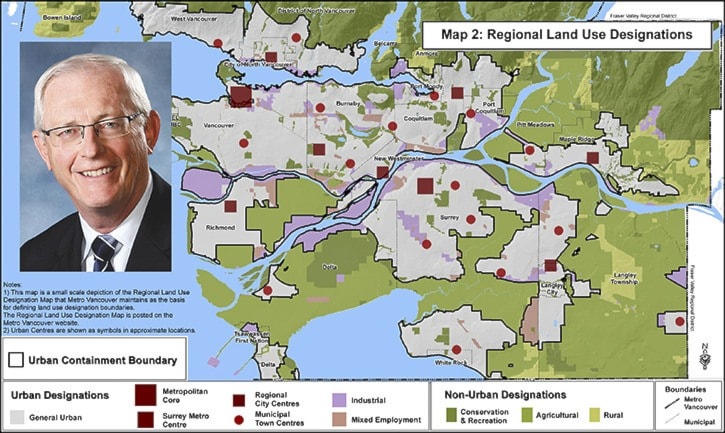Growth targets that would see White Rock’s population increase by 7,000 over the next 25 years are not legally binding, a planner with Metro Vancouver has confirmed.
The projections, laid out in the Regional Growth Strategy (RGS) and adopted by White Rock in March 2011, are “to assist long-range planning and are guidelines only,” senior regional planner Terry Hoff told Peace Arch News Monday.
“It’s not that municipalities are mandated to have that population,” Hoff said. “It’s just a way to give a sense of what we should start thinking about in the future in terms of the number of people, the dwelling units and the jobs that would be reasonable to expect.”
White Rock Mayor Wayne Baldwin, in a public letter to PAN last week, said the city is “required by provincial law” to follow the RGS and “take its share of the forecast growth within the region.”
When questioned Monday about whether the RGS was legally binding, Baldwin stood firm in his assertion.
“In terms of land use, it is binding,” Baldwin said, pointing to a B.C. Supreme Court case last year in which Metro Vancouver challenged the Township of Langley’s authority over development planning.
However, court records indicate that, in that case, the presiding judge sided with Langley, stating that Metro “does not have superiority over land-use management within the boundaries of a municipality.” An appeal of the decision by Metro was later rejected.
However, Baldwin noted that regardless of the outcome, the municipality still had to go to court.
“The region is prepared to uphold the terms of the agreement on the RGS and land use,” Baldwin said. “I’m not particularly interested in going to court with the region over a couple thousand people.”
Coun. Helen Fathers, who wrote a letter to PAN disputing Baldwin’s claim that the city is legally required to adhere to the RGS , said Monday she remembers the council of the day discussing the implications of signing on to the agreement.
“I distinctly remember it coming forward and there was much conversation about the document and what it meant and the implications,” Fathers said. “Clearly it was communicated that the numbers are guidelines only.”
However, Baldwin questioned Fathers’ comment, pointing out she voted in favour of approving growth projections.
“It seems more than a little strange, inconsistent and quite opportunistic politically to oppose it now that there is some ‘heat’ in the community over growth,” Baldwin wrote in an email to PAN Monday evening. “You may wish to ponder that.”
Coun. Lynne Sinclair, who was also on council at the time the RGS was adopted, told PAN she is “not the right person to answer” whether it was legally binding, but that the targets should be taken into consideration when making planning decisions.
“We’ve signed onto the agreement in the same sense and spirit that we intend to put in place decisions that reflect the document that we signed,” Sinclair said. “That doesn’t mean every development that comes forward is going to be approved.”
When the RGS came before council in 2011, a report presented by then-director of planning and operations referred to concerns that the city might not achieve the population and housing targets laid out in the RGS.
“Metro Vancouver’s response to those concerns was that the projections were ‘guidelines only and not binding’,” the report states.
According to Hoff – who lives in the White Rock/South Surrey community and was at the 2011 council meeting at which the RGS was adopted – one of the more “rigid” targets set by Metro Vancouver is the concentration of growth in the town centres.
“We have set regional targets saying that we’d like to get 40 per cent of our housing developments in our urban centres,” he said, noting “it makes sense” for both cities to accommodate growth in the town-centre area.
“What’s important is that growth is coming, and White Rock/South Surrey is a very attractive area,” he said.
